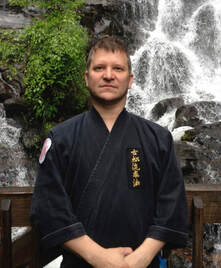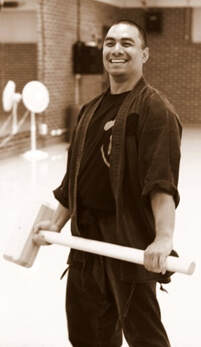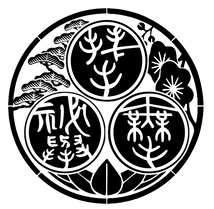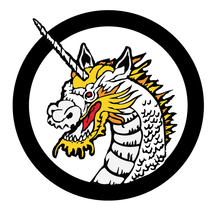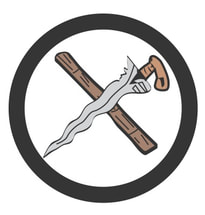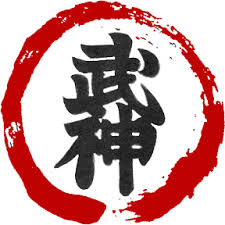We teach to Traditional Martial Arts in a modern society. Much of our training focuses on how traditional Martial Arts can apply to today.
We teach a variety of Martial Arts including Kosho Ryu Kempo, Chi Ling Pai Kung Fu, Escrima and Bujinkan Budo Taijutsu.
Old School Martial Arts is a proud member of the Martial Arts Collective Society, an organization founded to help preserve all Martial Arts.
We are proud to introduce Shidoshi Joe Bunales to our Dojo! He is teaching the traditional art of Bujinkan Budo Taijustsu
We teach a variety of Martial Arts including Kosho Ryu Kempo, Chi Ling Pai Kung Fu, Escrima and Bujinkan Budo Taijutsu.
Old School Martial Arts is a proud member of the Martial Arts Collective Society, an organization founded to help preserve all Martial Arts.
We are proud to introduce Shidoshi Joe Bunales to our Dojo! He is teaching the traditional art of Bujinkan Budo Taijustsu
|
Jon Ludwig Renshi has been a teacher of Kosho Ryu Kempo in the Sei Kosho Shorei Kai since 1994. He is also involved in maintaining the Martial Arts Collective Society.
He is also an instructor (Sifu) in Chi Ling Pai Kung Fu under Master Scott Felsen. Ludwig Renshi has studied many arts such as Kosho Ryu, Tae Kwon Do, Hapkido, Silat, Traditional Japanese Jujitsu, Escrima, Arnis and Kung Fu. He has a passion for the study of Martial Arts. He believes in an eclectic, well rounded approach to studying martial arts. |
Joseph Bunales, Sr. received master instructor (shihan) in Bujinkan Budo Taijutsu in 2013 and was instructor certified in April, 2006. Humble beginnings started at the age of 8 years old with various martial arts before focusing on Bujinkan Budo Taijutsu. Joe brings affiliation from the Chicago Bujinkan Shingitai-Ichi dojo to the Chicagoland midwest suburbs, and is known for cultivating the feeling of the "art" within “martial art” based on teachings from Soke Masaaki Hatsumi and Dai-Shihan (Senior Masters). Sensei Bunales has led martial arts programs in taijutsu at the Roselle Bujinkan Dojo, Alfred Campanelli YMCA, has been a senior instructor at workshop retreats since 2007 and has supported martial art demos at the Chicago Anime Con and the Anderson Japanese Gardens in Rockford, IL. He now teaches exclusively in the Woodridge, Downers Grove, Lisle area.
|
Kosho Ryu KempoKosho Ryu Kempo is a 750 old Japanese Martial Art. It was originally developed by Japanese Warrior Monks. The word Kempo translates to mean "Natural Law". Kosho Ryu Kempo is a refined study of the human body and strategy as it relates to self defense. Studies include empty handed self defense, weaponry, healing arts, philosophy, history, and strategy. The Kosho Ryu practitioner questions everything to find the most efficient method of movement.
For more information, visit the Sei Kosho Shorei Kai Homepage, our organization's official site. |
|
Bujinkan Budo Taijutsu
Bujinkan Budo Taijutsu was founded by Dr. Masaaki Hatsumi to both honor and study the knowledge of his teacher, the legendary figure known as the “Mongolian Tiger,” Toshitsugu Takamatsu. Nine martial lineages were entrusted to Hatsumi more than 60 years ago, each one an authentic warrior tradition tempered by the history of Japan. Bujinkan training is no less a modern resurgence of old-school thought akin to Bushi no michi, “the warrior path”, a broad-minded self-reliant warriorship that studies a range of tactics and strategies aimed at undoing the enemy to protect the life value – oneself, others and if possible, the attacker.
Taijutsu cultivates the development of natural responses. During initial training, larger, stronger, even multiple opponents can be defeated without reliance on brute force, speed or strength. Instead, the student’s instincts of initiative, acuity, and balance are sharpened as tools capable of subduing even the largest adversary at a time of their greatest disadvantage. The art’s principles also provide the foundation for weapons usage, where tactics and strategy are identical whether fighting unarmed or with any number of martial tools. This practicality prompts tens of thousands from around the world, many involved in law enforcement or military operations, to seek out training. The Marine Corps Martial Arts Program and the Federal Bureau of Investigation’s Defensive Tactics Program have both utilized Taijutsu principles as a basis for their instruction.
Taijutsu cultivates the development of natural responses. During initial training, larger, stronger, even multiple opponents can be defeated without reliance on brute force, speed or strength. Instead, the student’s instincts of initiative, acuity, and balance are sharpened as tools capable of subduing even the largest adversary at a time of their greatest disadvantage. The art’s principles also provide the foundation for weapons usage, where tactics and strategy are identical whether fighting unarmed or with any number of martial tools. This practicality prompts tens of thousands from around the world, many involved in law enforcement or military operations, to seek out training. The Marine Corps Martial Arts Program and the Federal Bureau of Investigation’s Defensive Tactics Program have both utilized Taijutsu principles as a basis for their instruction.
